JWT Authentication and Authorisation using Spring Boot 3 and Spring Security 6
In this tutorial, you will learn how to implement JWT authentication and authorization in a Spring Boot 3.0 with Spring Security 6 and PostgreSQL data
REST API is a way of accessing web services simply and flexibly without any processing. REST APIs provide simple, uniform interfaces because they can be used to make data, content, algorithms, media, and other digital resources available through web URLs.
However, due to the nature and mechanics underlying REST APIs, securing them is not always straightforward. What happens after the user submits his info?
In this article, we’ll cover one very powerful way to secure a REST API using JSON Web Tokens (JWT). Let’s get started!
Prerequisites
Spring Boot 3 +
Java 17 (Spring Security 6 requires JDK 17)
PostgreSQL
Postman
What is JWT?
JWT, or JSON Web Token, is an open standard used to share security information between two parties — a client and a server. Each JWT contains encoded JSON objects, including a set of claims. JWTs are signed using a cryptographic algorithm to ensure that the claims cannot be altered after the token is issued.
First, the user or client app sends a sign-in request. In this step. Once verified, the API will create a JWT and sign it using a secret key. Then, the API will return that token to the frontend application which will verify it on its side to ensure it's authenticated, and then use it on every HTTP request.
JWT structure
The token itself, which is returned by the API, is simply an encoded string. It consists of three concatenated Base64url-encoded strings, separated by dots:
Header: contains metadata about the type of token and the cryptographic algorithms used to secure its contents.
Payload: contain data about the request and the user making it.
Signature: used to validate that the token is trustworthy and has not been tampered with. When you use a JWT, you must check its signature before storing and using it.
Here is an example of the JWT and its structure:
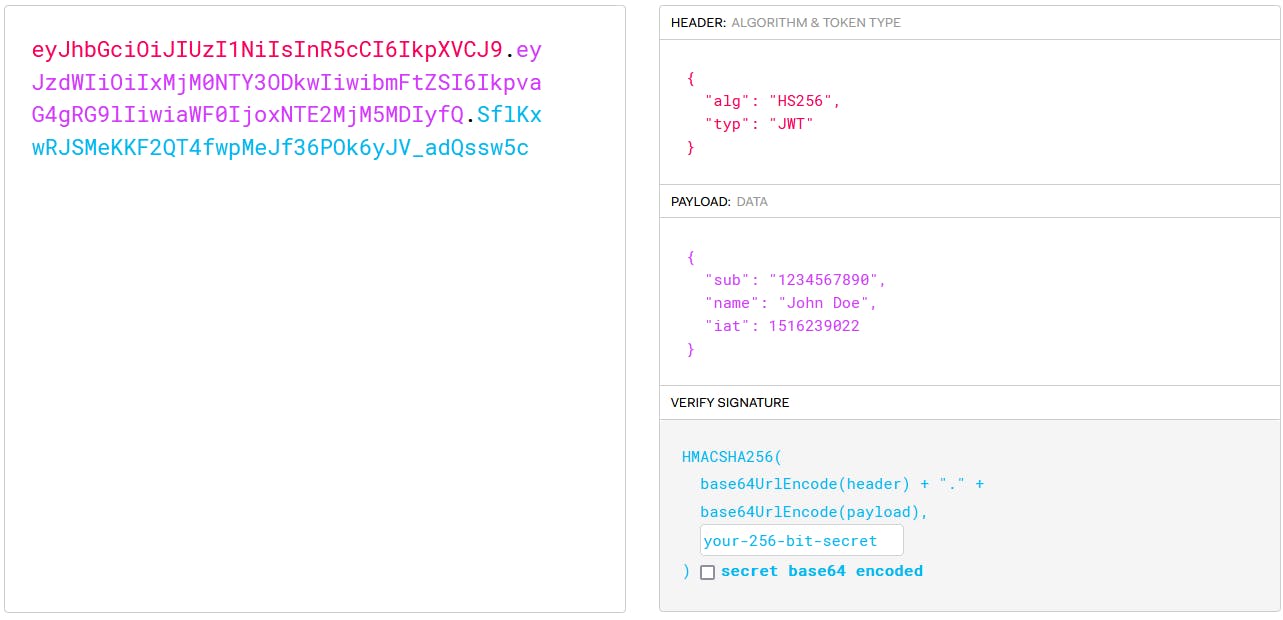
On the left you can see what a JWT looks like and on the right, you can see every part of the JWT after decoding.
Getting started
We will start by creating a Spring project from start.spring.io and by adding the dependencies we need which are Spring Web, PostgreSQL Driver, Spring Security and Lombok.

After generating the project extract it, open it in your IDE and wait until the IDE downloads all the dependencies.
Configure Spring Datasource, JPA, and App properties
Under src/main/resources change the application.properties extension to application.yml you can keep it the same but I prefer yaml open application.yml and add the following line:
spring:
datasource:
url: jdbc:postgresql://localhost:5432/yourDatabaseName
username: yourPostgresUserName
password: yourPostgresPassword
driver-class-name: org.postgresql.Driver
jpa:
hibernate:
ddl-auto: create-drop
show-sql: true
properties:
hibernate:
format_sql: true
database: postgresql
database-platform: org.hibernate.dialect.PostgreSQLDialect
- spring.jpa.hibernate.ddl-auto is used for database initialization. We set the value to create-drop value so that a table will be created in the database automatically when we run the spring boot application and the table will be dropped when we stop our application. For production, this property value should be changed.
Create the models and Implement the Repositories
Create the models
Under src/main/java/com.example.security creates a package called user.
Let's define our roles, and define an enum called Role with the following roles:
//Role.java
package com.example.security.user;
public enum Role {
User,
Admin
}
Now let's create a user model:
//User.java
package com.example.security.user;
import jakarta.persistence.*;
import lombok.AllArgsConstructor;
import lombok.Builder;
import lombok.Data;
import lombok.NoArgsConstructor;
import org.springframework.security.core.GrantedAuthority;
import org.springframework.security.core.authority.SimpleGrantedAuthority;
import org.springframework.security.core.userdetails.UserDetails;
import java.util.Collection;
import java.util.List;
@Data
@Builder
@NoArgsConstructor
@AllArgsConstructor
@Entity
@Table(name="_user")
public class User implements UserDetails {
@Id
@GeneratedValue
private Integer id;
private String firstname;
private String lastname;
private String email;
private String password;
@Enumerated(EnumType.STRING)
private Role role;
@Override
public Collection<? extends GrantedAuthority> getAuthorities() {
return List.of(new SimpleGrantedAuthority(role.name()));
}
@Override
public String getPassword() {
return password;
}
@Override
public String getUsername() {
return email;
}
@Override
public boolean isAccountNonExpired() {
return true;
}
@Override
public boolean isAccountNonLocked() {
return true;
}
@Override
public boolean isCredentialsNonExpired() {
return true;
}
@Override
public boolean isEnabled() {
return true;
}
}
Implement the Repositories
Now, our user model needs a repository for persisting and accessing data. Let's create our user repository:
//UserRepository.java
package com.example.security.user;
import org.springframework.data.repository.CrudRepository;
import org.springframework.stereotype.Repository;
import java.util.Optional;
@Repository
public interface UserRepository extends CrudRepository<User,Integer> {
Optional<User> findByEmail(String email);
}
Adding some JWT dependencies
In pom.xml we will add JWT dependencies:
<?xml version="1.0" encoding="UTF-8"?>
<project xmlns="http://maven.apache.org/POM/4.0.0" xmlns:xsi="http://www.w3.org/2001/XMLSchema-instance"
xsi:schemaLocation="http://maven.apache.org/POM/4.0.0 https://maven.apache.org/xsd/maven-4.0.0.xsd">
<modelVersion>4.0.0</modelVersion>
<parent>
<groupId>org.springframework.boot</groupId>
<artifactId>spring-boot-starter-parent</artifactId>
<version>3.0.2</version>
<relativePath/> <!-- lookup parent from repository -->
</parent>
<groupId>com.example</groupId>
<artifactId>security</artifactId>
<version>0.0.1-SNAPSHOT</version>
<name>security</name>
<description>Demo project for Spring Boot</description>
<properties>
<java.version>17</java.version>
</properties>
<dependencies>
<dependency>
<groupId>org.springframework.boot</groupId>
<artifactId>spring-boot-starter-data-jpa</artifactId>
</dependency>
<dependency>
<groupId>org.springframework.boot</groupId>
<artifactId>spring-boot-starter-security</artifactId>
</dependency>
<dependency>
<groupId>org.springframework.boot</groupId>
<artifactId>spring-boot-starter-web</artifactId>
</dependency>
<dependency>
<groupId>org.postgresql</groupId>
<artifactId>postgresql</artifactId>
<scope>runtime</scope>
</dependency>
<dependency>
<groupId>io.jsonwebtoken</groupId>
<artifactId>jjwt-api</artifactId>
<version>0.11.5</version>
</dependency>
<dependency>
<groupId>io.jsonwebtoken</groupId>
<artifactId>jjwt-impl</artifactId>
<version>0.11.5</version>
</dependency>
<dependency>
<groupId>io.jsonwebtoken</groupId>
<artifactId>jjwt-jackson</artifactId>
<version>0.11.5</version>
</dependency>
<dependency>
<groupId>org.projectlombok</groupId>
<artifactId>lombok</artifactId>
<optional>true</optional>
</dependency>
<dependency>
<groupId>org.springframework.boot</groupId>
<artifactId>spring-boot-starter-test</artifactId>
<scope>test</scope>
</dependency>
<dependency>
<groupId>org.springframework.security</groupId>
<artifactId>spring-security-test</artifactId>
<scope>test</scope>
</dependency>
</dependencies>
<build>
<plugins>
<plugin>
<groupId>org.springframework.boot</groupId>
<artifactId>spring-boot-maven-plugin</artifactId>
<configuration>
<excludes>
<exclude>
<groupId>org.projectlombok</groupId>
<artifactId>lombok</artifactId>
</exclude>
</excludes>
</configuration>
</plugin>
</plugins>
</build>
</project>
Configure spring security
Under src/main/java/com.example.security creates a package with the name config.
Create a security filter chain
Under the config package create SecurityConfiguration class:
//SecurityConfiguration.java
package com.example.security.config;
import lombok.RequiredArgsConstructor;
import org.springframework.context.annotation.Bean;
import org.springframework.context.annotation.Configuration;
import org.springframework.security.authentication.AuthenticationProvider;
import org.springframework.security.config.annotation.web.builders.HttpSecurity;
import org.springframework.security.config.annotation.web.configuration.EnableWebSecurity;
import org.springframework.security.config.http.SessionCreationPolicy;
import org.springframework.security.web.SecurityFilterChain;
import org.springframework.security.web.authentication.UsernamePasswordAuthenticationFilter;
@Configuration
@EnableWebSecurity
@RequiredArgsConstructor
public class SecurityConfiguration {
private final JwtAuthenticationFilter jwtAuthFilter;
private final AuthenticationProvider authenticationProvider;
@Bean
public SecurityFilterChain securityFilterChain(HttpSecurity http) throws Exception {
http
.csrf()
.disable()
.authorizeHttpRequests()
.requestMatchers("/api/v1/auth/**")
.permitAll()
.anyRequest()
.authenticated()
.and()
.sessionManagement()
.sessionCreationPolicy(SessionCreationPolicy.STATELESS)
.and()
.authenticationProvider(authenticationProvider)
.addFilterBefore(jwtAuthFilter, UsernamePasswordAuthenticationFilter.class);
return http.build();
}
}
What we did here is that we provided a new security filter chain so spring will create this bean and will use this bean instead the default one.
Now we need to create our JWT authentication filter and the authentication provider to make the security filter chain work.
@EnableWebSecurity allows Spring to find and automatically apply the class to global Web Security.
Create JWT authentication
Under the config package create JwtAuthenticationFilter class:
//JwtAuthenticationFilter.java
package com.example.security.config;
import jakarta.servlet.FilterChain;
import jakarta.servlet.ServletException;
import jakarta.servlet.http.HttpServletRequest;
import jakarta.servlet.http.HttpServletResponse;
import lombok.RequiredArgsConstructor;
import org.springframework.lang.NonNull;
import org.springframework.security.authentication.UsernamePasswordAuthenticationToken;
import org.springframework.security.core.context.SecurityContextHolder;
import org.springframework.security.core.userdetails.UserDetails;
import org.springframework.security.core.userdetails.UserDetailsService;
import org.springframework.security.web.authentication.WebAuthenticationDetailsSource;
import org.springframework.stereotype.Component;
import org.springframework.web.filter.OncePerRequestFilter;
import java.io.IOException;
@Component
@RequiredArgsConstructor
public class JwtAuthenticationFilter extends OncePerRequestFilter {
private final JwtService jwtService;
private final UserDetailsService userDetailsService;
@Override
protected void doFilterInternal(
@NonNull HttpServletRequest request,
@NonNull HttpServletResponse response,
@NonNull FilterChain filterChain
) throws ServletException, IOException {
final String authHeader = request.getHeader("Authorization");
final String jwt;
final String userEmail;
if(authHeader == null || !authHeader.startsWith("Bearer ")) {
filterChain.doFilter(request,response);
return;
}
jwt = authHeader.substring(7);
userEmail = jwtService.extractUsername(jwt);
if(userEmail != null && SecurityContextHolder.getContext().getAuthentication() == null) {
UserDetails userDetails = this.userDetailsService.loadUserByUsername(userEmail);
if(jwtService.isTokenValid(jwt, userDetails)) {
UsernamePasswordAuthenticationToken authToken = new UsernamePasswordAuthenticationToken(
userDetails,
null,
userDetails.getAuthorities()
);
authToken.setDetails(
new WebAuthenticationDetailsSource().buildDetails(request)
);
SecurityContextHolder.getContext().setAuthentication(authToken);
}
}
filterChain.doFilter(request, response);
}
}
What we did here is override the doFilterInternal function from our OncePerRequestFilter class. First, we need to check if the authorization header from our request is different from null or starts with the bearer word. After that, we extract our JWT from the authorization header and used a function from JwtSecvice class called extractUsername to extract user email from the JWT. Now we check if the email different from null we load our user details using a function from UserDetailsService class with the email and after we check if the token is valid if it is valid spring boot approves our request.
Now we will create the JWT service class we used in the class above.
Create JWT service
Under the config package create JwtService class:
//JwtService.java
package com.example.security.config;
import io.jsonwebtoken.Claims;
import io.jsonwebtoken.Jwts;
import io.jsonwebtoken.SignatureAlgorithm;
import io.jsonwebtoken.io.Decoders;
import io.jsonwebtoken.security.Keys;
import org.springframework.security.core.userdetails.UserDetails;
import org.springframework.stereotype.Service;
import java.security.Key;
import java.util.Date;
import java.util.HashMap;
import java.util.Map;
import java.util.function.Function;
@Service
public class JwtService {
private static final String SECRET_KEY = "6A576D5A7134743777217A25432A462D4A614E645267556B5870327235753878";
public String extractUsername(String token) {
return extractClaim(token,Claims::getSubject);
}
public <T> T extractClaim(String token, Function<Claims, T> claimsResolver) {
final Claims claims = extractAllClaims(token);
return claimsResolver.apply(claims);
}
public String generateToken(UserDetails userDetails) {
return generateToken(new HashMap<>(), userDetails);
}
public String generateToken(
Map<String, Object> extraClaims,
UserDetails userDetails
) {
return Jwts
.builder()
.setClaims(extraClaims)
.setSubject(userDetails.getUsername())
.setIssuedAt(new Date(System.currentTimeMillis()))
.setExpiration(new Date(System.currentTimeMillis() + 1000 * 60 * 24))
.signWith(getSigningKey(), SignatureAlgorithm.HS256)
.compact();
}
public boolean isTokenValid(String token, UserDetails userDetails) {
final String username = extractUsername(token);
return (username.equals(userDetails.getUsername())) && !isTokenExpired(token);
}
private boolean isTokenExpired(String token) {
return extractExpiration(token).before(new Date());
}
private Date extractExpiration(String token) {
return extractClaim(token, Claims::getExpiration);
}
private Claims extractAllClaims(String token) {
return Jwts
.parserBuilder()
.setSigningKey(getSigningKey())
.build()
.parseClaimsJws(token)
.getBody();
}
private Key getSigningKey() {
byte[] keyBytes = Decoders.BASE64.decode(SECRET_KEY);
return Keys.hmacShaKeyFor(keyBytes);
}
}
This class contains a bunch of methods that we will use in our spring applications.
Define application config
Under the config package create ApplicationConfig class:
//ApplicationConfig.java
package com.example.security.config;
import com.example.security.user.UserRepository;
import lombok.RequiredArgsConstructor;
import org.springframework.context.annotation.Bean;
import org.springframework.context.annotation.Configuration;
import org.springframework.security.authentication.AuthenticationManager;
import org.springframework.security.authentication.AuthenticationProvider;
import org.springframework.security.authentication.dao.DaoAuthenticationProvider;
import org.springframework.security.config.annotation.authentication.configuration.AuthenticationConfiguration;
import org.springframework.security.core.userdetails.UserDetailsService;
import org.springframework.security.core.userdetails.UsernameNotFoundException;
import org.springframework.security.crypto.bcrypt.BCryptPasswordEncoder;
import org.springframework.security.crypto.password.PasswordEncoder;
@Configuration
@RequiredArgsConstructor
public class ApplicationConfig {
private final UserRepository repository;
@Bean
public UserDetailsService userDetailsService() {
return username -> repository.findByEmail(username)
.orElseThrow(() -> new UsernameNotFoundException("User not found"));
}
@Bean
public AuthenticationProvider authenticationProvider() {
DaoAuthenticationProvider authProvider = new DaoAuthenticationProvider();
authProvider.setUserDetailsService(userDetailsService());
authProvider.setPasswordEncoder(passwordEncoder());
return authProvider;
}
@Bean
public AuthenticationManager authenticationManager(AuthenticationConfiguration config) throws Exception {
return config.getAuthenticationManager();
}
@Bean
public PasswordEncoder passwordEncoder() {
return new BCryptPasswordEncoder();
}
}
Create Authentication Apis
Under src/main/java/com.example.security creates a package called auth.
Create controller
1. Demo Controller
Under src/main/java/com.example.security creates a package called demo.
Under the demo package create DemoController class:
//DemoController.java
package com.example.security.demo;
import org.springframework.http.ResponseEntity;
import org.springframework.web.bind.annotation.GetMapping;
import org.springframework.web.bind.annotation.RequestMapping;
import org.springframework.web.bind.annotation.RestController;
@RestController
@RequestMapping("/api/v1/demo")
public class DemoController {
@GetMapping
public ResponseEntity<String> sayHello() {
return ResponseEntity.ok("Hello from secured endpoint");
}
}
The demo controller is for testing our spring boot application, if the token was provided with the API, should return Hello from secured endpoint and if not it will throw a 403 error.
2. Authentication Controller
Under auth package create AuthenticationController class:
//AuthenticationController.java
package com.example.security.auth;
import lombok.RequiredArgsConstructor;
import org.springframework.http.ResponseEntity;
import org.springframework.web.bind.annotation.PostMapping;
import org.springframework.web.bind.annotation.RequestBody;
import org.springframework.web.bind.annotation.RequestMapping;
import org.springframework.web.bind.annotation.RestController;
@RestController
@RequestMapping("/api/v1/auth")
@RequiredArgsConstructor
public class AuthenticationController {
private final AuthenticationService service;
@PostMapping("/register")
public ResponseEntity<AuthenticationResponse> register(
@RequestBody RegisterRequest request
) {
return ResponseEntity.ok(service.register(request));
}
@PostMapping("/authenticate")
public ResponseEntity<AuthenticationResponse> authenticate(
@RequestBody AuthenticationRequest request
) {
return ResponseEntity.ok(service.authenticate(request));
}
}
Now we need to create the AuthenticationService class, request classes and response class.
Define payloads for Authentication Controller
Let's create our requests classes and response class:
Requests
Authentication Request
Under auth package define the AuthenticationRequest class:
//AuthenticationRequest.java package com.example.security.auth; import lombok.AllArgsConstructor; import lombok.Builder; import lombok.Data; import lombok.NoArgsConstructor; @Data @Builder @NoArgsConstructor @AllArgsConstructor public class AuthenticationRequest { private String email; String password; }
Register Request
Under auth package define the RegisterRequest class:
//RegisterRequest.java package com.example.security.auth; import lombok.AllArgsConstructor; import lombok.Builder; import lombok.Data; import lombok.NoArgsConstructor; @Data @Builder @NoArgsConstructor @AllArgsConstructor public class RegisterRequest { private String firstname; private String lastname; private String email; private String password; }
Responses
Authentication Response
Under auth package define AuthenticationResponse class
//AuthenticationResponse.java package com.example.security.auth; import lombok.AllArgsConstructor; import lombok.Builder; import lombok.Data; import lombok.NoArgsConstructor; @Data @Builder @NoArgsConstructor @AllArgsConstructor public class AuthenticationResponse { private String token; }
Create an Implementation class for our controller
Under auth package define AuthenticationService class:
//AuthenticationService.java
package com.example.security.auth;
import com.example.security.config.JwtService;
import com.example.security.user.Role;
import com.example.security.user.User;
import com.example.security.user.UserRepository;
import lombok.RequiredArgsConstructor;
import org.springframework.security.authentication.AuthenticationManager;
import org.springframework.security.authentication.UsernamePasswordAuthenticationToken;
import org.springframework.security.crypto.password.PasswordEncoder;
import org.springframework.stereotype.Service;
@Service
@RequiredArgsConstructor
public class AuthenticationService {
private final UserRepository repository;
private final PasswordEncoder passwordEncoder;
private final JwtService jwtService;
private final AuthenticationManager authenticationManager;
public AuthenticationResponse register(RegisterRequest request) {
var user = User.builder()
.firstname(request.getFirstname())
.lastname(request.getLastname())
.email(request.getEmail())
.password(passwordEncoder.encode(request.getPassword()))
.role(Role.User)
.build();
repository.save(user);
var jwtToken = jwtService.generateToken(user);
return AuthenticationResponse.builder()
.token(jwtToken)
.build();
}
public AuthenticationResponse authenticate(AuthenticationRequest request) {
authenticationManager.authenticate(
new UsernamePasswordAuthenticationToken(
request.getEmail(),
request.getPassword()
)
);
var user = repository.findByEmail(request.getEmail())
.orElseThrow();
var jwtToken = jwtService.generateToken(user);
return AuthenticationResponse.builder()
.token(jwtToken)
.build();
}
}
This class above contains the implementation of the authenticate and register method we used in our controller.
Testing our application
First, let's run our application to see if it's working:

After we checked that our spring boot application is working let's test our APIs.
Register API:
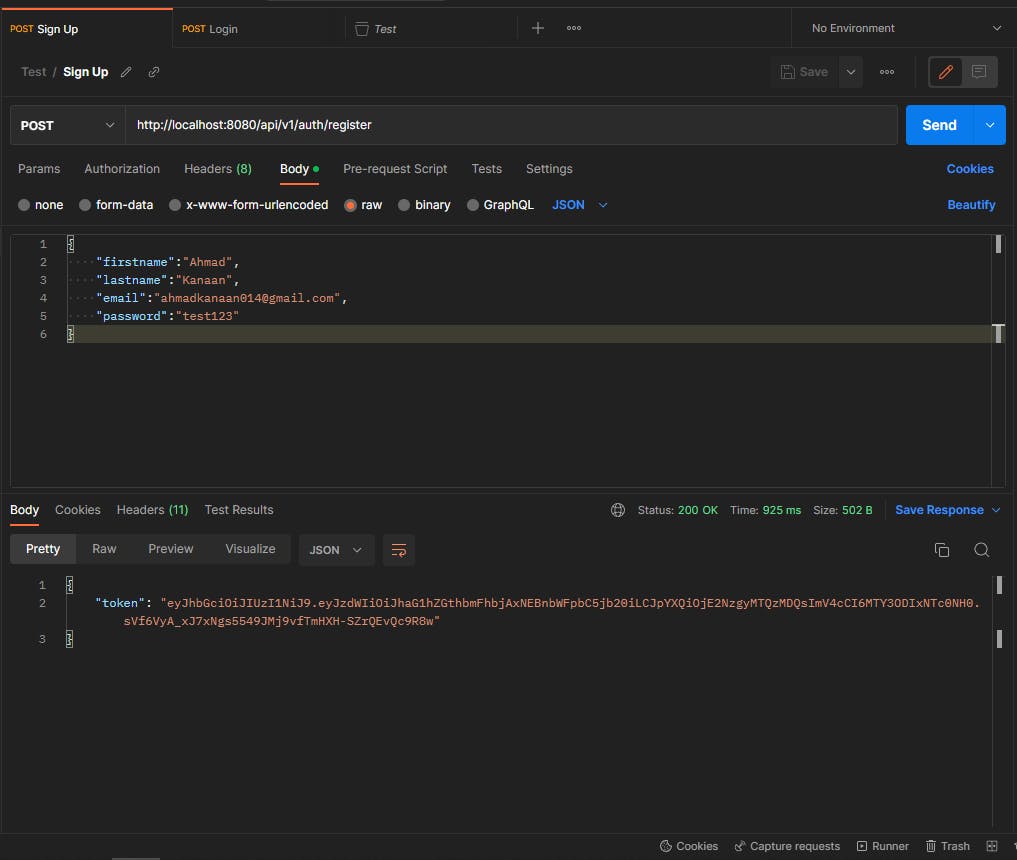
Login API:
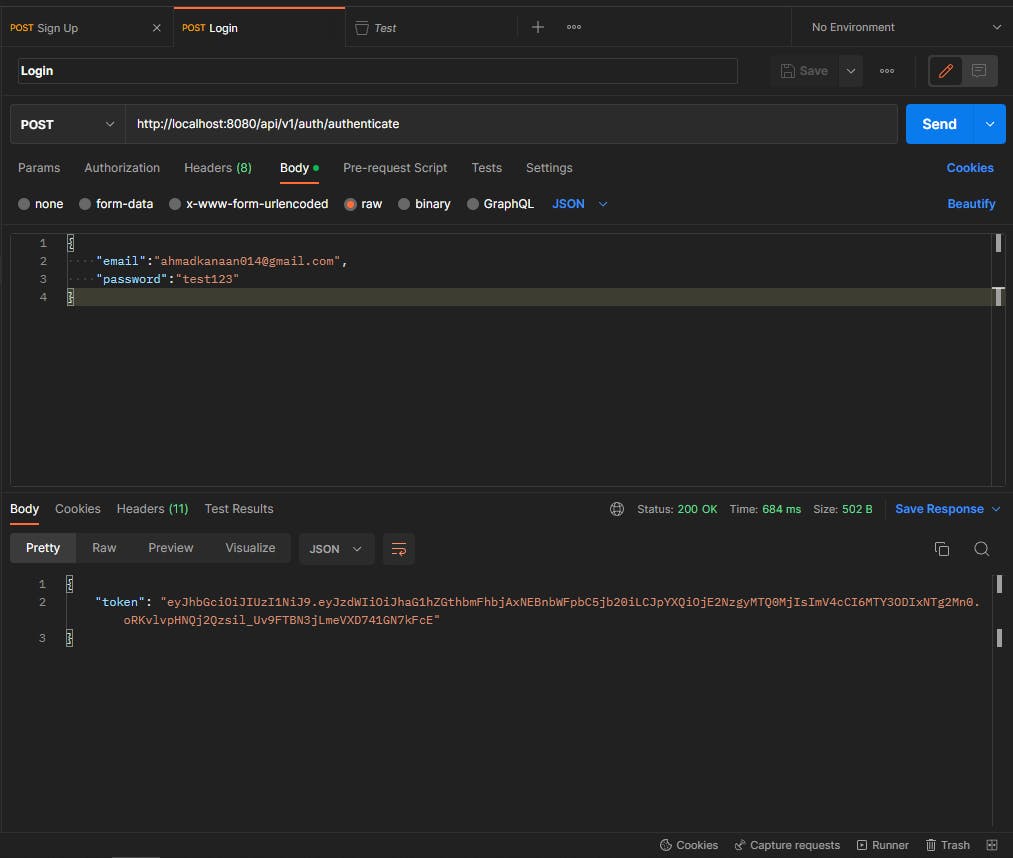
Demo API:
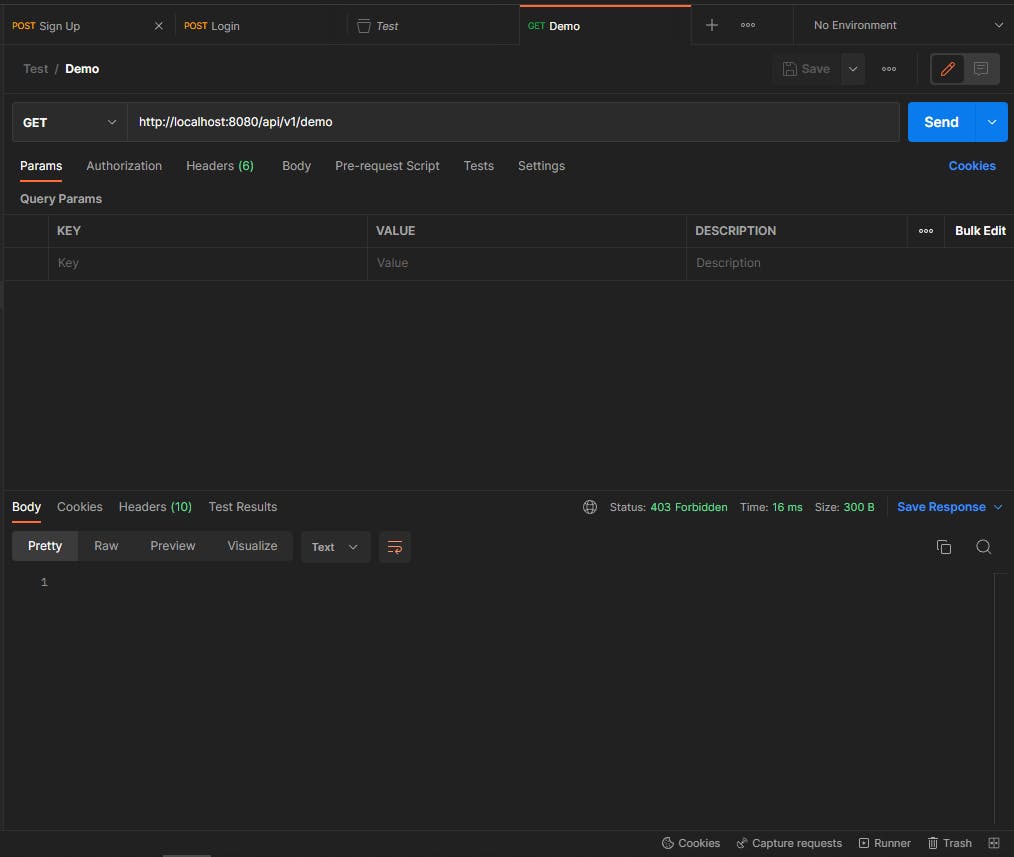
As I said before if we didn't provide the JWT token it will throw a 403 error.
Now let's provide our API with the JWT token:

After you click the authorization tab change the type to Bearer token and paste the token returned by the login API.
Now let's try again:
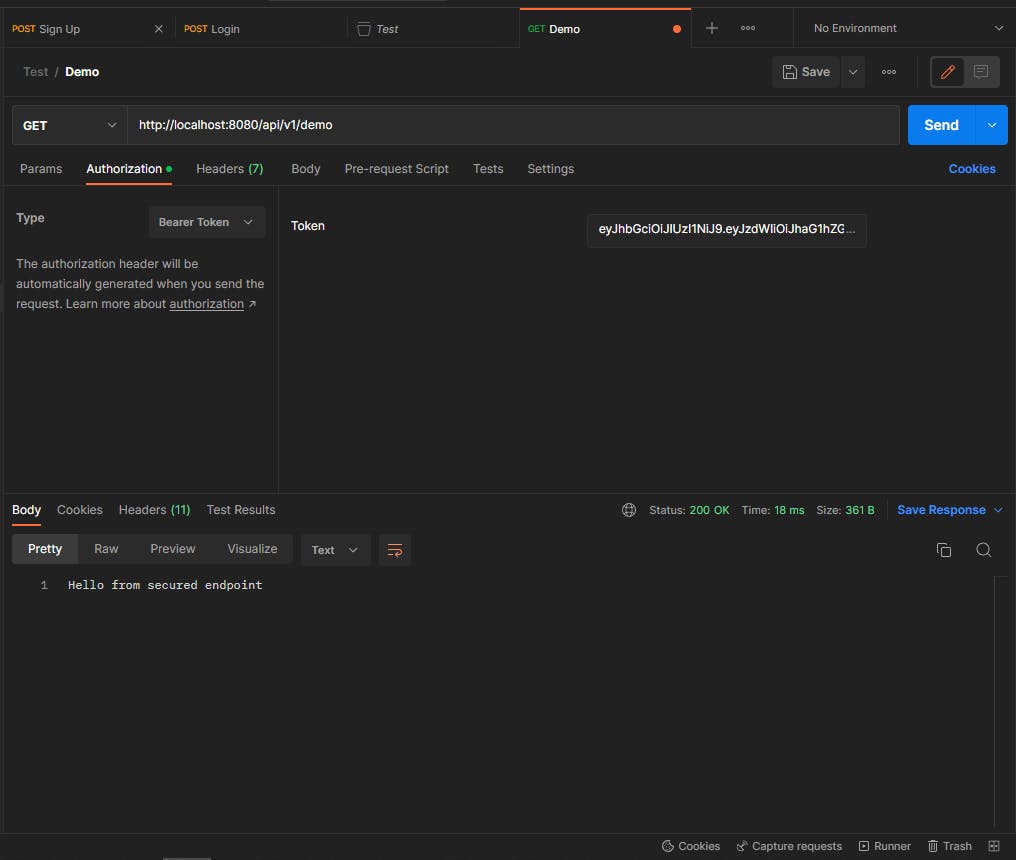
Our spring boot application is running successfully and well-secured with JWT authentication.
Conclusion
Well done !!. In this article, We have seen how to secure a REST API with Spring Boot 3.0, Spring Security 6.0, and JWT.
The complete source code is available on GitHub.
If you enjoyed this article, please like and comment.
If you like my article follow and subscribe to my newsletter.
Thanks for reading!
